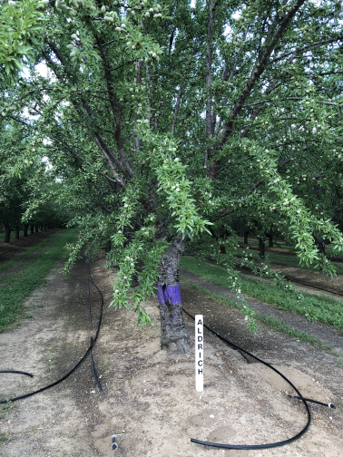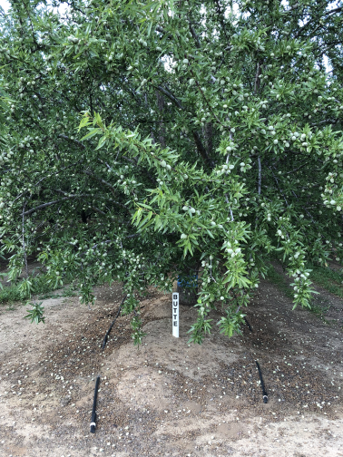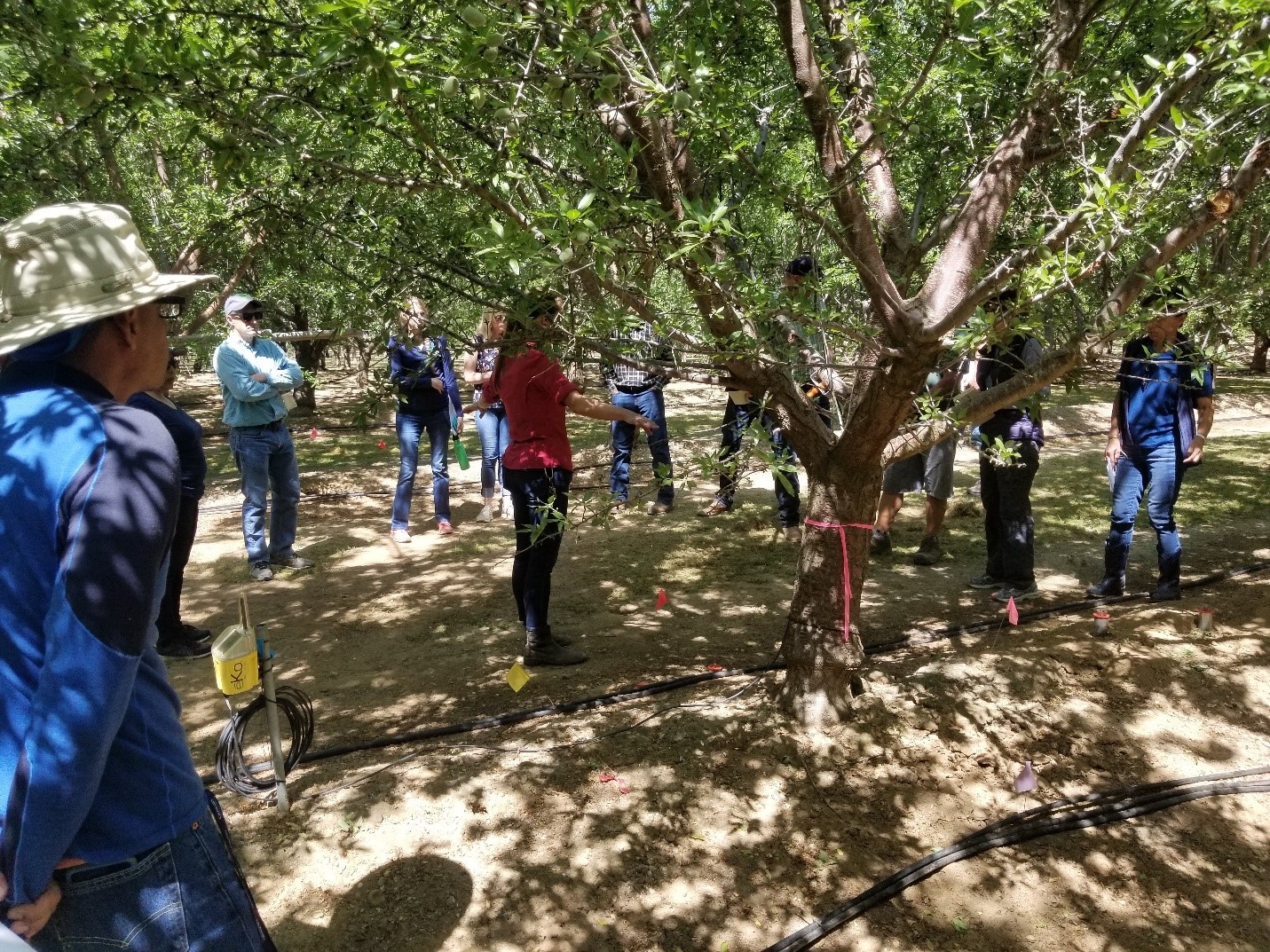![]()
As farmers face increasing pressure to use water wisely due to environmental and policy changes in California, the importance of developing site-specific irrigation practices has never been more important.
Site Specific Irrigation
Site-specific irrigation management can account for heterogeneous soils, variable topography, diverse tree varieties and ages, changing environmental conditions, and more. In almond orchards, which typically have two or three varieties to improve cross-pollination, diverse tree varieties offer a potential application of site-specific irrigation management.
My major advisor, Dr. Isaya Kisekka, and I have begun an experiment to investigate the potential of irrigation by variety as a form of site-specific irrigation. Could farmers improve quality, yield and/or crop per drop by independently irrigating tree varieties?
The motivation to study irrigation by variety comes from the growth patterns of almond trees. Different almond varieties experience critical growth stages, such as bloom, hull-split, and harvest, at different times during the year. When one variety has certain water requirements, another variety in the same orchard may be in a different growth stage with different water requirements.
Hull Split
For example, the timing of hull split varies among almond varieties. An almond farmer may strategically reduce irrigation (i.e. regulated deficit irrigation) to promote the onset of hull split, reduce the risk of hull rot, and decrease water use. However, it can be difficult to determine when to reduce irrigation in almond orchards with multiple varieties without an irrigation system that offers farmers the ability to implement regulated deficit irrigation in one variety and not the other(s).
As a result of conventional irrigation systems that have only one line supplying water to all varieties within the orchard, irrigation strategies are geared toward the needs of highly profitable varieties, such as Nonpareil. Without an irrigation system capable of irrigating by variety, a farmer would probably choose to irrigate according to the needs of the most profitable variety (e.g. Nonpareil). In other words, the farmer would cut back irrigation in all varieties to promote the onset of hull split in the Nonpareil even though late-maturing varieties in the same orchard may not be ready for reduced irrigation. When Nonpareil is in the hull split stage and could benefit from reduced irrigation, late-maturing pollinator varieties, such as Butte and Aldrich, are still in the kernel filling stage and would prefer well-watered conditions.

Reduing Harvest Complications
Irrigating multi-variety almond orchards around harvest is also tricky. Farmers need to reduce irrigation immediately before harvest to avoid bark-splitting during shaking, but this is also a critical time for some varieties when buds are internally splitting into next season’s buds and need water. Furthermore, after the first variety has been harvested, almonds are drying on the floor, limiting irrigation in all varieties, even the ones that haven’t been harvested. Irrigation systems that offer flexibility to independently irrigate varieties may reduce complications that occur during harvest.
In micro-irrigated orchards arranged with whole rows alternating among varieties, irrigation management by variety could be straightforward to implement. Independent submains could supply water to each variety. Alternatively, individual rows could be interfaced with independent valves that could be opened/closed depending on the needs of the tree variety. During the harvest period, double-drip laterals could be modified into single-drip laterals by blocking one side and shaken almonds could be blown to the other side to allow half the row to be irrigated while the other half stays dry. The irrigation system could be modernized to allow each side of the row to be independently irrigated. This would offer greater flexibility for irrigating at the right place, at the right time, and the right amount, depending on variety-specific growth stages and harvest-related constraints.
While the potential benefits of irrigating by variety may seem apparent, a full-on experiment is needed to back up the notion. As a part of my PhD research, my goal is to determine if irrigating by variety could offer potential quality, yield, productivity, and profitability improvements to almond growers.

Regulated Deficit Irrigation Research
In 2018, we conducted a regulated deficit irrigation experiment in a mature almond orchard at Nickels Soil Lab near Arbuckle, California. The four-acre orchard alternates among Butte, Aldrich, and Nonpareil varieties. We interfaced a remotely controlled irrigation system to the orchard that allowed us to implement four different irrigation treatments in each variety. The four irrigation treatments were (1) 100/100/100 percent ET (evapotranspiration) , (2) 100/75/75 percent ET, (3) 100/75/100 percent ET, and (4) 100/50/125 percent ET, where the first number was pre-hull split treatment, the second number was the hull split to harvest treatment, and the third number was the postharvest treatment. We replicated each combination of variety and irrigation treatment five times.
From the onset of hull split to the end of postharvest irrigation, we measured midday stem water potential in all replicates once every irrigation period to assess how the varieties physiologically responded to the irrigation treatments. We found that during the hull split to harvest period, the Aldrich stem water potential was significantly lower (more negative) than the Butte and Nonpareil. This was an interesting finding that encouraged us to look more closely at whether irrigation by variety could improve quality, yield, productivity, and profitability.
In order to test the hypothesis that irrigation by variety could improve yield, quality, and profitability, we will begin a modified study in 2019 where we compare 50 percent and 75 percent ET hull split treatments implemented according to (1) Nonpareil hull split and harvest timing and (2) according to variety-specific hull split and harvest timing. The former case simulates an orchard without the ability of irrigating by variety (i.e. everything is based on Nonpareil needs) whereas the latter case simulates an orchard with the ability to irrigate by variety.
After the Nonpareil harvest, the shaken almonds will be blown to one side of the rows. The dripline on the side with the almonds will be blocked and only the other side will be irrigated by doubling the runtime as though it were double dripline. This will allow us to continue irrigating in the Butte and Aldrich varieties while Nonpareil almonds are drying. During this time, we will intensively monitor soil water content using transects of neutron probe access tubes on both the irrigated and non-irrigated sides in each variety. We will determine yield and quality in all treatments. Quality parameters to be measured include navel orangeworm, mold, blank, double, twin, shrivel, gum, sealed shell count, kernel count, and kernel dimensions. We will conduct statistical analyses to determine if there are any significant differences in yield, quality parameters, and stem water potential between irrigating by variety and not irrigating by variety at the two hull split regulated deficit irrigation levels (50 percent and 75 percent).
We also plan to conduct an economic analysis on irrigation management by variety. The cost of modifying the irrigation system to allow for independent irrigation by variety and resulting changes in net profit from production will be considered. How can we re-engineer the irrigation system of an almond orchard to implement variety-specific irrigation and what is the return on investment? Irrigation by variety could be a potential application for emerging remote irrigation control systems on the market that conveniently allow farmers to compartmentalize their orchards into different treatment zones.
Results from this year will be presented at the Almond Conference in 2019.
















